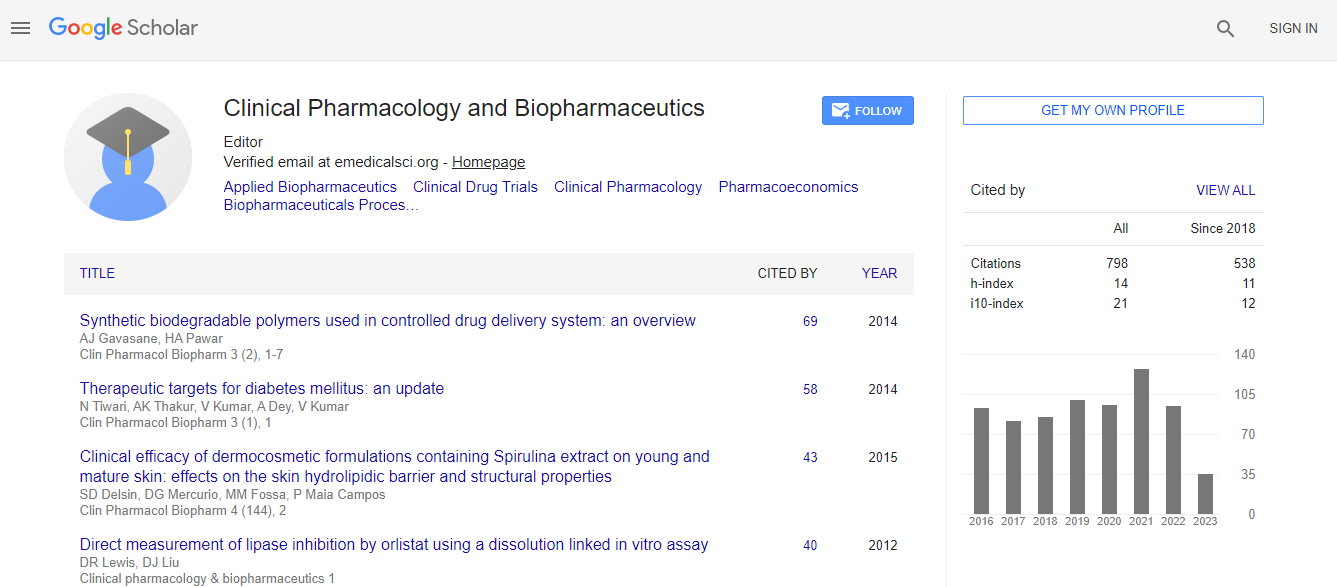Our Group organises 3000+ Global Conferenceseries Events every year across USA, Europe & Asia with support from 1000 more scientific Societies and Publishes 700+ Open Access Journals which contains over 50000 eminent personalities, reputed scientists as editorial board members.
Open Access Journals gaining more Readers and Citations
700 Journals and 15,000,000 Readers Each Journal is getting 25,000+ Readers
Google Scholar citation report
Citations : 1089
Clinical Pharmacology & Biopharmaceutics received 1089 citations as per Google Scholar report
Clinical Pharmacology & Biopharmaceutics peer review process verified at publons
Indexed In
- CAS Source Index (CASSI)
- Index Copernicus
- Google Scholar
- Sherpa Romeo
- Genamics JournalSeek
- RefSeek
- Hamdard University
- EBSCO A-Z
- OCLC- WorldCat
- Publons
- Euro Pub
- ICMJE
Useful Links
Recommended Journals
Related Subjects
Share This Page
Fluorescent carbon dots as a theranostic agent for controlled drug release
International Conference and Expo on Biopharmaceutics
Madhuri Sharon
Solapur University, India
Posters-Accepted Abstracts: Clin Pharmacol Biopharm
Abstract
Photoluminescent carbon-dots are envisaged as drug delivery vehicle due to their high chemical stability, water solubility, resistance to photodegradation, biocompatibility, low toxicity and easily tuneable optical properties. Use of natural as well as chemical precursors for synthesis of crystalline C-dots and conjugates of C-dot+mesoporous silica and C-dot+gold nanorod using microwave assisted heating in alkaline environment and their use for delivery of therapeutic payloads is reported here. Sucrose density gradient centrifugation was used to separate C-dots from debris. Optical and morphological properties of the C-dots were confirmed by UVVis spectroscopy, Fluorescence spectroscopy, Raman, XRD and FE-SEM. C-dots were biocompatible against MDCK cells. Drugs studied include ciprofloxacin hydrochloride, Doxorubicin, Haloperidol and Curcumin. C-dots/drug+linker complex were dialyzed against nanopure water to remove unattached drug and characterized by FTIR and TGA. Drug loading efficiency and release kinetics were calculated as per different mathematical models. Cipro and C-dots conjugate enhanced the antimicrobial activity against both model gram positive and negative microorganisms. Bovine Serum Albumin protected C-dots and doxorubicin complex having Folic Acid (FA) as navigational molecules have shown ├ó┬?┬?First Order├ó┬?┬? release of drug. Moreover, epifluorescence microscopy of HeLa-cells exhibited bright green fluorescence due to internalization of C-dots specifically targeted with FA in HeLa cells. When C-dots and GNR complex was used for anchoring DOX via covalent and non-covalent pH sensitive chemical bonds it could load 94% drug that rapidly got released under the influence of near-infrared thus paving way for an efficient nano-carrier, for controlled drug release as well as for bio-imaging, thereby, serving as potential tool for theranostics.Biography
Email: sharonmadhuri@gmail.com

 Spanish
Spanish  Chinese
Chinese  Russian
Russian  German
German  French
French  Japanese
Japanese  Portuguese
Portuguese  Hindi
Hindi 
